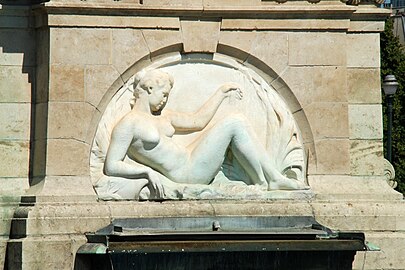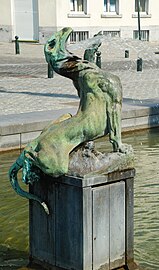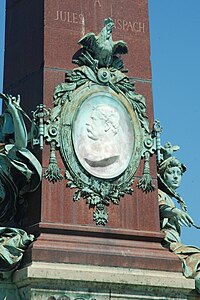Anspach Fountain
 From Wikipedia - Reading time: 6 min
From Wikipedia - Reading time: 6 min
 | |
 | |
| 50°51′13″N 4°20′49″E / 50.85361°N 4.34694°E | |
| Location | Square des Blindés / Pantsertroepensquare 1000 City of Brussels, Brussels-Capital Region, Belgium |
|---|---|
| Designer | Charles-Émile Janlet |
| Type | Fountain |
| Material | Blue stone, pink granite and bronze |
| Height | 20 m (66 ft) |
| Beginning date | 1895 |
| Completion date | 1897 |
| Dedicated to | Jules Anspach |
| Dismantled date | 1973 |
The Anspach Fountain (French: Fontaine Anspach; Dutch: Anspachfontein) is an eclectic-style fountain-obelisk erected between 1895 and 1897 in the centre of the Place de Brouckère/De Brouckèreplein in Brussels, Belgium.[1] Designed by the architect Charles-Émile Janlet, it is dedicated to the memory of Jules Anspach, a former mayor of the City of Brussels.[2][3][1]
The monument was dismantled in 1973 following construction work on the Brussels Metro.[4] It was reinstalled in 1981 in its current location on the Square des Blindés/Pantsertroepensquare, between the Quai aux Briques/Baksteenkaai and the Quai au Bois à Brûler/Brandhoutkaai, in the Sainte-Catherine/Sint Katelijne neighbourhood.[5][3][1]
History
[edit]Construction
[edit]The Anspach Fountain was designed by the architect Charles-Émile Janlet and erected between 1895 and 1897 in the centre of the Place de Brouckère/De Brouckèreplein, left empty by the destruction of the former Temple of the Augustinians.[6][1][7] The fountain pays homage to Jules Anspach, mayor of the City of Brussels from 1863 to 1879, as well as promoter of the covering of the river Senne (1867–1871) and the creation of the Central Boulevards.[2][3][1] This monument stood exactly in the axis of the Boulevard Anspach/Anspachlaan, like a regulator of traffic at the birth of the fork between the Boulevard Émile Jacqmain/Émile Jacqmainlaan and the Boulevard Adolphe Max/Adolphe Maxlaan. It was considered in its time the most beautiful and the grandest in the city.[4]

Disassembly and reassembly
[edit]The fountain was dismantled and removed in 1973 to make way for access to De Brouckère metro station,[4] with the pieces temporarily stored in a warehouse. The authorities had promised to put the monument back in place after the works, but it was eventually reinstalled in May 1981 in a basin that occupies the space between the Quai aux Briques/Baksteenkaai and the Quai au Bois à Brûler/Brandhoutkaai, in the Sainte-Catherine/Sint Katelijne neighbourhood, some 700 metres (2,300 ft) from the Place de Brouckère.[5][3][1]
Description
[edit]The eclectic-style monument, 20 metres (66 ft) high,[4] is made up of a Swedish granite obelisk surmounting a blue stone pedestal surrounded by a basin.[3] Inseparable from the monumental perspective of the boulevards—and yet moved following the works of the metro—it is, through its dedication and former location, a tribute to Anspach.[4][3][8]
Pedestal
[edit]The blue stone pedestal is adorned with a marble bas-relief depicting an allegory of The Covering of the Senne, represented by a naked woman seated in a tunnel,[9] the work of the sculptor Paul De Vigne,[4] as well as dolphin spitters made by the sculptor Georges Houtstont. The pedestal is surrounded by a four-lobed basin decorated with mascaron spitters also made by Houtstont[a][1] and six chimeras sculpted by Godefroid Devreese.[b][5] On the pedestal, there are inscriptions recalling the names of the artists and the circumstances of the monument's construction.[4]
-
Dolphin by Georges Houtstont
Obelisk
[edit]The pink granite obelisk, 11 metres (36 ft) high,[1] bears at its base a white marble medallion with Anspach's image by Paul De Vigne, surrounded by bronze allegories of The Municipal Judiciary and The Grateful City of Brussels by the sculptor Julien Dillens.[4][5] The Municipal Judiciary's hair is decorated with oak leaves, a symbol of power. In her left hand, she holds a rudder, an allusion to the city's government, around which a snake coils, symbolising the prudence with which the mayor manages the city. The owl on her head represents wisdom and the scales at her feet justice. The Grateful City of Brussels bears a crown in the shape of walls, an allusion to the fact that Brussels was a fortified city in the Middle Ages. Anspach's medallion is surmounted by a rooster, symbolising vigilance.[1]
The top of the obelisk bears a bronze ornament made by Pierre-Jean Braecke, depicting the town in medieval times, surmounted by a Gothic spire decorated with finials and ending with an effigy of Saint Michael, the patron saint of the City of Brussels, slaying a dragon or demon.[4][5] The sculptor introduced an innovation into the traditional iconography of Saint Michael by representing him naked, following the example of ancient art.[10] The upper part is also decorated with four coats of arms, referring to the historical Brussels' Guilds of Crossbowmen, Harquebusiers, Archers and Fencers.[4][10]
-
Statue of Saint Michael slaying the dragon by Pierre-Jean Braecke
-
The Municipal Judiciary by Julien Dillens
-
The Grateful City of Brussels by Dillens
See also
[edit]References
[edit]Footnotes
[edit]Citations
[edit]- ^ a b c d e f g h i De Roose 1999, p. 50.
- ^ a b Mardaga 1989, p. 200, 366.
- ^ a b c d e f Eggericx 1997, p. 31.
- ^ a b c d e f g h i j Mardaga 1989, p. 200.
- ^ a b c d e Loze, Vautier & Vestre 1990, p. 40–41.
- ^ Eggericx 1997, p. 30.
- ^ Demey 2013, p. 212–213.
- ^ Demey 2013, p. 546.
- ^ Blyth 2021, p. 145.
- ^ a b "Sint-Michiel in het Brusselse straatbeeld". Historiek (in Dutch). 13 December 2018. Retrieved 19 December 2023.
Bibliography
[edit]- Blyth, Derek (2021). The 500 Hidden Secrets of Brussels. Second Edition. Antwerp: Luster. ISBN 978-9-4605-8303-2.
- Demey, Thierry (1990). Bruxelles, chronique d'une capitale en chantier (in French). Vol. I: Du voûtement de la Senne à la jonction Nord-Midi. Brussels: Paul Legrain/CFC. OCLC 44643865.
- Demey, Thierry (2013). Bruxelles, des remparts aux boulevards (in French). Brussels: Badeaux. ISBN 978-2-930609-02-7.
- De Roose, Fabien (1999). De fonteinen van Brussel (in Dutch). Tielt: Lannoo. ISBN 978-90-209-3838-8.
- Eggericx, Laure (1997). Les Boulevards du Centre. Bruxelles, ville d'Art et d'Histoire (in French). Vol. 20. Brussels: Centre d'information, de Documentation et d'Etude du Patrimoine.
- Loze, Pierre; Vautier, Dominique; Vestre, Marina (1990). Guide de Bruxelles XIXème et Art Nouveau (in French). Brussels: Eiffel Editions - CFC Éditions.
- Le Patrimoine monumental de la Belgique: Bruxelles (PDF) (in French). Vol. 1A: Pentagone A-D. Liège: Pierre Mardaga. 1989.
External links
[edit] Media related to Anspach Fountain at Wikimedia Commons
Media related to Anspach Fountain at Wikimedia Commons
 KSF
KSF
![Dolphin by Georges Houtstont [fr]](https://upload.wikimedia.org/wikipedia/commons/thumb/c/cc/Belgique_-_Bruxelles_-_Fontaine_Anspach_-_10.jpg/405px-Belgique_-_Bruxelles_-_Fontaine_Anspach_-_10.jpg)
![Mascaron by Pierre-Jean Braecke [fr]](https://upload.wikimedia.org/wikipedia/commons/thumb/4/45/Belgique_-_Bruxelles_-_Fontaine_Anspach_-_12.jpg/180px-Belgique_-_Bruxelles_-_Fontaine_Anspach_-_12.jpg)

![Statue of Saint Michael slaying the dragon by Pierre-Jean Braecke [fr]](https://upload.wikimedia.org/wikipedia/commons/thumb/f/f8/Belgique_-_Bruxelles_-_Fontaine_Anspach_-_07.jpg/200px-Belgique_-_Bruxelles_-_Fontaine_Anspach_-_07.jpg)


